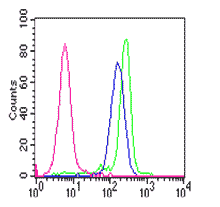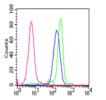Product Details
| Alternative Name: | CD66c, NCA |
| |
| Clone: | 9A6 |
| |
| Host: | Mouse |
| |
| Isotype: | IgG1 |
| |
| Immunogen: | Tumor cell lines expressing human CEACAM6. |
| |
| UniProt ID: | P40199 |
| |
| Species reactivity: | Human
|
| |
| Crossreactivity: | Does not cross-react with human CEACAM1, 3, 4, 5, 7 or 8. |
| |
| Applications: | ELISA, Flow Cytometry, IHC (FS), WB
|
| |
| Purity Detail: | Protein G-affinity purified. |
| |
| Quality Control: | Routinely tested by flow cytometry on BOSC cells transiently transfected with a NCA expression vector. |
| |
| Formulation: | Liquid. In PBS, pH 7.2. Contains no preservatives. |
| |
| Handling: | For maximum product recovery after thawing, centrifuge the vial before opening the cap. Avoid freeze/thaw cycles. After opening, prepare aliquots and store at -20°C. |
| |
| Shipping: | Blue Ice |
| |
| Short Term Storage: | +4°C |
| |
| Long Term Storage: | -20°C |
| |
| Scientific Background: | The normal cross-reacting antigen (NCA) or CEACAM6 belongs to the carcinoembryonic antigen (CEA) gene family. CEACAM6 is a GPI-anchored membrane protein with a single N domain, which shows structural homology to the immunoglobulin variable domains, followed by two immunoglobulin constant-like domains. |
| |
| Regulatory Status: | RUO - Research Use Only |
| |

Figure: Reactivity of FITC-labelled MAb to CEACAM6 (human) (9A6) (Prod. No.
ALX-805-083) with polymorph nuclear cells. 2x10
5 polymorph nuclear cells (PMN) with (green) or without (blue) prior incubation with PMA were reacted for 30 min. at 4°C with FITC conjugated MAb to CEACAM6 (human) (9A6) (40µg/ml) or with an isotype matched FITC-conjugated irrelevant MAb (red), then washed twice. PMN expression of CEACAM6 is constitutively and can be augmented by treatment with PMA."
Please mouse over
Product Literature References
Granulocyte CEACAM3 is a phagocytic receptor of the innate immune system that mediates recognition and elimination of human-specific pathogens: T. Schmitter, et al.; J. Exp. Med.
199, 35 (2004),
Abstract;
Full Text
Carcinoembryonic antigen: W. Zimmermann; Wiley Encyclopedia of Molecular Medicine 459 (2002), (Book chapter),
Carcinoembryonic antigen-related cell adhesion molecule 1 expression and signaling in human, mouse, and rat leukocytes: evidence for replacement of the short cytoplasmic domain isoform by glycosylphosphatidylinositol-linked proteins in human leukocytes: B.B. Singer, et al.; J. Immunol.
168, 5139 (2002),
Abstract;
Full Text
Nuclear factor-kappa B directs carcinoembryonic antigen-related cellular adhesion molecule 1 receptor expression in Neisseria gonorrhoeae-infected epithelial cells: P. Muenzner, et al.; J. Biol. Chem.
277, 7438 (2002),
Abstract;
Full Text
Homophilic adhesion of human CEACAM1 involves N-terminal domain interactions: structural analysis of the binding site: S.M. Watt, et al.; Blood
98, 1469 (2001),
Abstract;
Full Text
Pathogenic Neisseria trigger expression of their carcinoembryonic antigen-related cellular adhesion molecule 1 (CEACAM1; previously CD66a) receptor on primary endothelial cells by activating the immediate early response transcription factor, nuclear facto: P. Muenzner, et al.; J. Biol. Chem.
276, 24331 (2001),
Abstract;
Full Text
Carcinoembryonic antigen family members CEACAM6 and CEACAM7 are differentially expressed in normal tissues and oppositely deregulated in hyperplastic colorectal polyps and early adenomas: S. Scholzel, et al.; Am. J. Pathol.
156, 595 (2000),
Abstract;
Full Text
Carcinoembryonic antigen family receptor specificity of Neisseria meningitidis Opa variants influences adherence to and invasion of proinflammatory cytokine-activated endothelial cells: P. Muenzner, et al.; Infect. Immun.
68, 3601 (2000),
Abstract;
Full Text
CEA-related proteins on human urothelial cell lines of different transformation grades: A. Krop-Watorek, et al.; Cancer Lett.
139, 15 (1999),
Abstract;
Opa binding to cellular CD66 receptors mediates the transcellular traversal of Neisseria gonorrhoeae across polarized T84 epithelial cell monolayers: J. Wang, et al.; Mol. Microbiol.
30, 657 (1998),
Abstract;
Full Text
CD66 family Workshop: Binding of myeloid blind panel antibodies and CD66 Subsection antibodies to HeLa transfectants expressing individual CD66 molecules: F. Grunert; Leukocyte Typing VI: White cell Differentiation Antigens (1996), Garland Publishing Inc., New York and London, pp. 1012,
Expression of the CEA gene family members NCA-50/90 and NCA-160 (CD66) in childhood acute lymphoblastic leukemias (ALLs) and in cell lines of B-cell origin: H. Hanenberg; Leukemia
12, 2127 (1994),
Abstract;
A polymerase-chain-reaction assay for the specific identification of transcripts encoded by individual carcinoembryonic antigen (CEA)-gene-family members: J. Thompson, et al.; Int. J. Cancer
55, 311 (1993),
Abstract;
Determination of the specificities of monoclonal antibodies recognizing members of the CEA family using a panel of transfectants: S. Daniel, et al.; Int. J. Cancer
55, 303 (1993),
Abstract;
Biochemical characterization and tissue distribution of the Cora antigen, a cell surface glycoprotein differentially expressed on malignant and benign gastrointestinal epithelia: H.G. Gottlinger, et al.; Cancer Res.
48, 2198 (1988),
Abstract;
General Literature References
The carcinoembryonic antigen (CEA) family: structures, suggested functions and expression in normal and malignant tissues: S. Hammarstrom; Semin. Cancer Biol.
9, 67 (1999), (Review),
Abstract;
Carcinoembryonic antigen gene family: molecular biology and clinical perspectives: J.A. Thompson, et al.; J. Clin. Lab. Anal.
5, 344 (1991), (Review),
Abstract;










